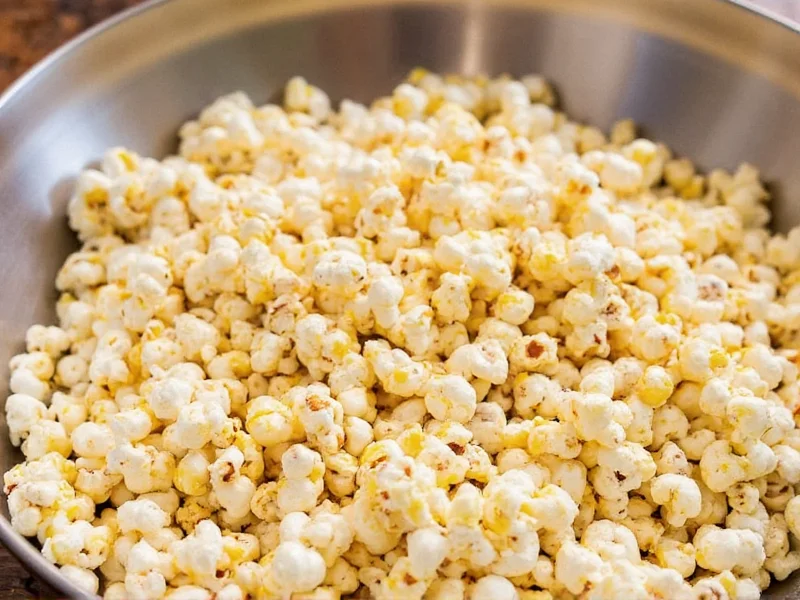Understanding what makes genuine kettle corn seasoning special starts with its historical roots. Originating with German and Dutch settlers in colonial America, this snack was traditionally prepared by kettle operators who added sugar to popcorn along with the salt typically used. The unique cooking method created a light caramel coating that distinguishes kettle corn from regular popcorn.
The Science Behind Authentic Kettle Corn Flavor
The magic of kettle corn happens through the Maillard reaction and caramelization. When sugar hits the hot oil in the kettle (typically around 400°F), it melts and begins to caramelize. As the popcorn kernels pop, they're coated in this sweet mixture, which then crystallizes into a delicate, slightly crunchy shell. The salt isn't just sprinkled on top—it's incorporated during the cooking process, creating that perfect sweet-salty balance that makes kettle corn irresistible.
Traditional Kettle Corn Seasoning Ingredients
Authentic kettle corn uses remarkably few ingredients, but the ratios matter significantly. Unlike commercial versions that often include artificial flavors and preservatives, the traditional recipe relies on natural components:
| Ingredient | Traditional Use | Modern Variations |
|---|---|---|
| Corn oil or sunflower oil | Base cooking oil (neutral flavor) | Coconut oil (for richer flavor) |
| Popcorn kernels | White or yellow hull varieties | Specialty heirloom kernels |
| Granulated sugar | White cane sugar (1:4 ratio to kernels) | Brown sugar, maple sugar, or coconut sugar |
| Salt | Fine sea salt (added during cooking) | Flavored salts or finishing salts |
| Optional | None | Spices like cinnamon, nutmeg, or cayenne |
How to Make Kettle Corn Seasoning from Scratch
Creating authentic kettle corn requires attention to timing and temperature. The seasoning isn't added after popping—it's part of the cooking process itself. Here's the traditional method:
- Heat 3 tablespoons of oil in a heavy-bottomed pot or traditional copper kettle
- Add 3-4 popcorn kernels to test the temperature (they should pop within 30 seconds)
- Once hot, add 1/3 cup popcorn kernels and 2 tablespoons sugar
- Cover with a lid, leaving a small gap for steam to escape
- Shake constantly as kernels begin popping
- When popping slows to 2-3 seconds between pops, remove from heat
- Immediately add 1 teaspoon fine salt and shake to distribute evenly
- Let cool completely before storing to maintain crispness
Common Mistakes in Homemade Kettle Corn Seasoning
Many home cooks struggle with kettle corn because of these frequent errors:
- Adding sugar too early - Sugar burns at lower temperatures than oil smokes, so adding it with the oil guarantees burnt seasoning
- Incorrect sugar-to-kernel ratio - Too much sugar creates a hard candy shell; too little misses the authentic flavor profile
- Using coarse salt - Fine salt dissolves better in the residual heat and coats more evenly
- Adding all seasoning after popping - The magic happens when sugar caramelizes during popping
- Storing while warm - Trapped moisture makes kettle corn chewy rather than crisp
Variations for Different Dietary Preferences
While traditional kettle corn seasoning uses white sugar, several adaptations maintain authenticity while accommodating different dietary needs:
For sugar-conscious versions, replace half the white sugar with monk fruit sweetener that can withstand high heat. The 1:1 substitution ratio works well for those monitoring sugar intake without sacrificing the characteristic caramel notes.
Crafting gluten-free kettle corn seasoning is naturally straightforward since the traditional recipe contains no gluten-containing ingredients. Just verify your salt doesn't contain anti-caking agents with gluten.
When making vegan kettle corn seasoning, ensure your sugar is processed without bone char. Many organic cane sugars meet this requirement while maintaining the necessary caramelization properties.
Storage Techniques for Maximum Freshness
Proper storage determines whether your homemade kettle corn maintains its signature crisp texture. The key is controlling moisture exposure:
- Store in airtight containers with silica gel packets to absorb ambient moisture
- Avoid refrigeration, which introduces condensation when removed
- For long-term storage (beyond 2 weeks), freeze in vacuum-sealed bags
- Never store near strong-smelling foods—kettle corn readily absorbs odors
- Revive stale kettle corn by reheating at 250°F for 5-7 minutes
Understanding Kettle Corn Seasoning vs Regular Popcorn Seasoning
The fundamental difference lies in when and how flavorings are applied. Regular popcorn seasoning typically refers to dry spice blends added after popping, while authentic kettle corn seasoning is created through the cooking process itself.
Commercial "kettle corn" products often misrepresent the traditional method, using artificial flavorings sprayed onto already-popped corn. True kettle corn develops its flavor profile through the caramelization process during popping, creating a distinctive texture where the seasoning becomes part of the popcorn rather than merely coating it.











 浙公网安备
33010002000092号
浙公网安备
33010002000092号 浙B2-20120091-4
浙B2-20120091-4